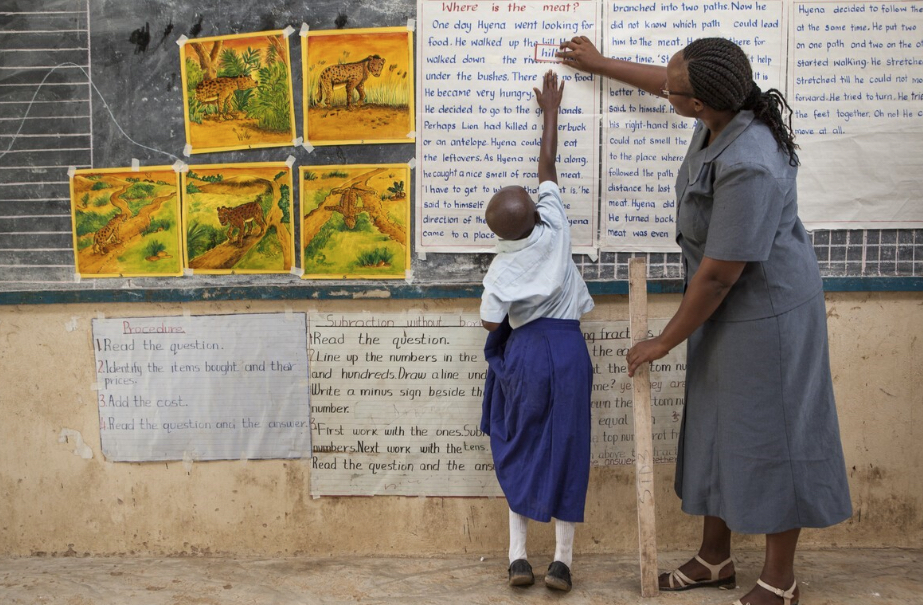
Engaged teachers inspire engaged learners | Photo credit: Lucas Cuervo Moura
Every classroom requires a few basic things to function: a teacher, learning materials, and a safe environment for students to learn. All classrooms exist in different contexts and all learners build their knowledge and skills in different ways. Teachers must be able to adapt their lessons so that they are inclusive and engaging for everyone in the classroom – including themselves. The Innovative Pedagogies Project has been a collaboration between the Education Commission, the Aga Khan Foundation, Samuel Hall, and the Government of Kenya to advance the use of inclusive, engaging, and adaptive (IEA) pedagogies in Kenyan classrooms.
Recognizing the challenges teachers face to effectively engage IEA pedagogies to deliver the competency-based curriculum (CBC), AKF has also been supporting educators in Kenya (and worldwide) to develop their own approaches to teaching through Human-Centered Design (HCD) through Schools2030. HCD is a design thinking approach that puts people at the centre of innovation. Using this principle, Schools2030 supports teachers and students to design and implement low-cost and scalable classroom innovations to improve holistic learning outcomes and learning environments to achieve Sustainable Development Goal 4: inclusive and equitable quality education for all.
Said Baya Kombo demonstrates how HCD can promote teacher-led innovations that address challenges an facilitate the use of IEA pedagogies. “For a long time, we looked outside for solutions to our problems (but)… I’ve discovered that the solutions are within. We get our answers from the people who are closest to us and from materials around us.”

During his training, Said realized the power of finding solutions from within | Photo credit: Kevin Oloo (Aga Khan Foundation, Kenya)
Said has been a teacher for 17 years. He has seen the education landscape change a great deal, most recently with the advent of the CBC. By exploring the problems and engaging his creative potential, Said has designed innovations to keep his teaching relevant. “I have a slew of ideas for my class that I’d like to put into action. Many of them don’t require a financial commitment, so I’m already using them in class. I’ve discovered that learning is more enjoyable as a result.”
Said has introduced the TECOP Learning Approach in his school, which is a collaborative digital platform that brings together parents, teachers, and learners to support activities that build reading and comprehension skills through technology. Using the tablets distributed by the Ministry of Education under the DigiSchools programme, learners will access place-based readers using three critical actions in developing reading skills: Hearing, Seeing, and Doing. Said expects that this will lead to parents actively participating in their children’s learning and learners realising both academic and non-academic holistic learning outcomes.
This opportunity to think critically and engage creativity has enabled Tabitha Wangoi – a Biology and Chemistry teacher from Mombasa – think beyond cost that made her ideas feel her ideas were unrealistic. “Through design thinking, I was able to see the solutions are actually within. In fact, you don’t have to think of a solution as something massive. A big problem can be solved by doing something small.” Tabitha has introduced a mathematics hour every week for students to discuss an assigned topic in a group, a session she calls “Finding Fun in Numbers.” The students present what they’ve learned and their presentations are recorded using tablets to Google Classroom so these can be referred to in the future.

Tabitha enjoyed collaborating with fellow teachers during the HCD training | Photo credit: Kevin Oloo (Aga Khan Foundation, Kenya)
For Tabitha, the most valuable part of Design Thinking has been coming together with other teachers and building a peer support network. “When you talk to another teacher from a different school, you realise that you are dealing with the same issues,” she continues, “It gives you an idea of the approach you can take to overcome a challenge in your school. There was a lot of collaboration and teamwork.” Since taking part, Tabitha says that she and her colleagues are more supportive of each other’s ideas and encourage one another to try new IEA pedagogies to improve learning outcomes.
